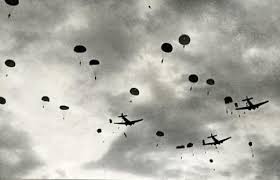American paratroopers
American paratroopers of the 82th (All American) & 101th (Screaming Eagles) landed as one of the first liberating divisions during WW2 on European grounds (Normandy: July 1944). Later on they also were the first ones to land on Dutch grounds during operation Market Garden (Eindhoven & surroundings: August 1944). Both airborne operations were the largest airborne operations ever done and uniforms and gear changed from one operation to the other, based on their combat experience.
My collection exists of all types of original uniforms used during these landings: the early model M41 (standard issue) uniform with corcoran jumpboots (= GIR = Glider infantry regiment), the rare model M42 uniform with corcoran jumpboots (= PIR = Paratrooper infantry regiment. With T5 parachute harnas: 1943 dated), the model M43 uniform with rigger made modified M43 pants with big baggy pockets added to support extra ammunition (= PIR = Paratrooper infantry regiment). The model M43 uniform with buckle boots was first introduced for operation Market Garden (August 1944).
The paratroopers wear the various types of M1 para helmets used during WW2, incl. original unit markings: the M1 model (with 327th marking for the M41 GIR), the M2 model (with 101 type camoflage for the M42 PIR. Provenance: Normandy), the M1C model (with 501th markings for the M43 PIR). The M1C paratrooper helmet with flexible bales was the latest model used during WW2. Original paratrooper helmets with unit markings are rare to find these day's.
The American paratrooper with the M42 uniform is equipped with a rare T5 parachute harness (provenance: Normandy) which had 2 parachutes (1 camo and 1 extra white parachute): the front parachute was in cause the main chute did not open. The British paratroopers jumped with only 1 main parachute (due to economical reasons and the low altitude they had to jump anyway).
Also you will see the 2 types of dropping containers with colored (red) dropping chutes used by the Americans (every color had its specialized loading. Red stands for ammunition): the A4 (for medical and food supplies) and the A5 (for weapons and ammunition). In the back an US folding handcart.
British paratroopers
British paratroopers of the 6th airborne brigade landed as one of the first liberating divisions during WW2 on European grounds (Normandy: July 1944). Later on they also were the first ones to land on Dutch grounds during operation Market Garden (Arnhem: August 1944). The Arnhem battle appeared 1 bridge too far for the British forces, as they lost this battle. Both airborne operations were the largest airborne operations ever done.
My collection exists of all types of uniforms used during these landings: the early war P37 model with second model jump smock and the P40 model with first pattern jump smock.
The paratrooper with the X type parachute harnas (wearing the first model para helmet) also carries an original and very rare leg bag (provenance: Normandy) as well as a lee enfield rifle jump carrier for paratroopers.
Also a SAS (special forces) soldier is represented with it's camo over-smock and -pants. In front of him a BSA folding bike with gear and later model leg bag. In his hand a bright yellow recognition scarf to flag to overflying airplanes.
The paratroopers wear the various types of para helmets; the first model (1942: with fibre rim and leather chin straps), the second model (1943: with leather chin straps) and the third model (1943: with canvas chin band).
The British paratroopers jumped with the X Type parachute harnas (with 1 parachute on the back) over their step in over smock (to keep their gear in place and prevent it being stuck with the parachute lines). These smocks were thrown away right after the jump, together with the parachute & harnas.
Also you will see 2 types of dropping containers used: the (metal) CLE dropping container with medical markings (provenance: battle of Arnhem) and the wicker pannier for medical and food supplies. Both with colored dropping chutes (kaki and white). The wicker pannier has original Polish markings (provenance: battle of Arnhem) and is located in the British folding handcart.
A very rare folding well bike (1944 frame nr. and early type motor + tank) can be seen in front of the handcart. These paratrooper scooters could be folded and than transported within a dropping container.
In the back the famous Rupert with parachute (a very rare decoy paratrooper doll to distract the enemy).

